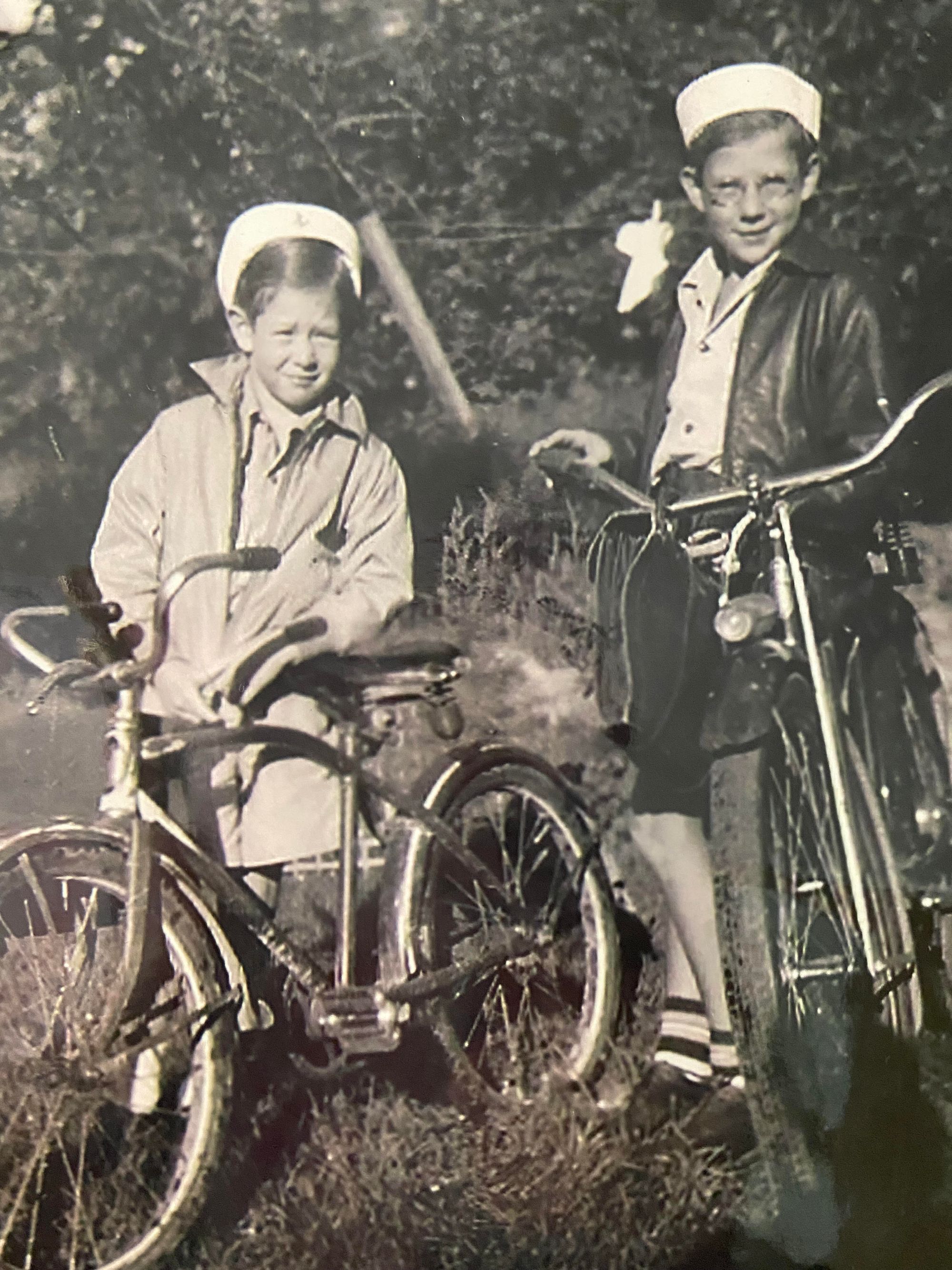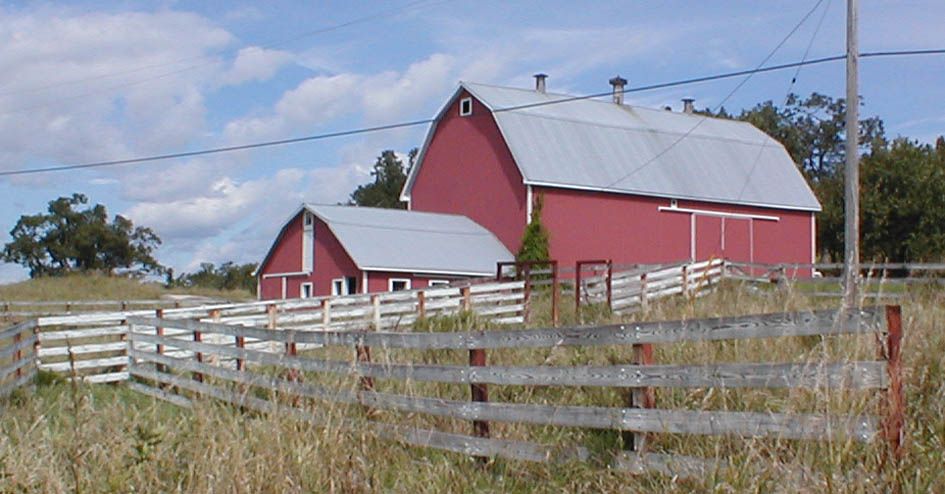Date: Grindstone Island, New York, circa 1940’s:
Worn smooth into the meadow was the cow path leading to the barn. Our farm had about 20 milk cows and the path was the route our cattle followed to the barn from the meadow and back again. They would line up and seemed to play “Follow the Leader” on each trip heading out to the pasture to feed and again on the return trip to the barn to be milked. Only on rare occasions would the whole herd not follow one cow. The path was started, I would guess, with the very first cow that walked along to feed in these pastures. These pathways turned quickly and were always the easiest route, never going straight up a hill – instead it would usually go along the side of a hill and around big rocks. It was now August, and it was threshing time on the farm. School was two weeks away from starting up again. Our oat field was cut and threshed in June when the fields were green. It was replaced with brown grass and a field of alfalfa. We could look down and see those fields from the hill near our barn, about a half mile away. They were shining bright green, just across the road from my uncle Leon’s (Dano) farm.

Our barn, the big red one on the south side Grindstone Island (can be seen straight across the river from Clayton), was built with a large underground stable. The barn was constructed in 1912 or so, according to a date painted on the inside. The barn had concrete floors, an enclosed pen, and a large grain shed, which despite being mostly underground, stayed relatively dry. It was obviously built by men who knew how to build barns. One side of the stable was intended for milking cows and controlling them with the stalls and headlocks. The cows would enter the barn and go to their designated space to eat fresh hay while they stuck their head through the headlock space. When exiting the back barn door after milking, the first step down was onto the cow path. A slight uphill and you went around a large formation of granite rocks imbedded in the earth, a common sight on Grindstone. The cow path curved around the big rocks, went through the fields, and continued for about a half mile. These paths were worn down and smoothed to hard dirt with no rocks and perfect for bare feet to run along on. Each summer we gave up wearing shoes when school ended. By July, the calluses on our feet were thick and we could withstand just about any surface to walk or run on that the island provided.
The cow path sloped, passing beneath an old white oak tree, through a gate and a wet area when there was rain. Through this gate, the ground was broken up by hooves stepping into the wet soil. A few feet away, the ground was solid again, and the cow path resumed its way down the hill toward the Dano Farm. Running along the path with bare feet would send small puffs of dust during dry weather. Life was great!
A short distance ahead, the path turned slightly to the west, skirted along a small hill, and then disappeared into a small creek. The creek was dry now and with pitch black soil on display, this was the rich soil my mother used to start her plants. The path was worn down on the north side of the pond from the cows, and from there, the path started almost immediately to the barn.
From the top of this small hill, there was quite a view. You could see the water shed of Delaney’s Marsh, and Black’s Hill as it rose above the meadow, about a mile away. To the west, there is another low hill that splits the water shed between upper Thurso Marsh and Delaney Bay and you could see my uncle Billy Graham’s farmhouse. From this vantage point, you could also see the Dano farm, the Rusho farm, the Kittle farm, and the Potter farm. The Atherton farm water shed drained into a large ditch through the upper grasses of Delaney’s Marsh. These farms are spread before me like a map in my mind still, some 80 years later.

As I walked along the path, I observed a noisy, late-sitting Killdeer bird as it flopped around on the ground. The Killdeer hopped away from her nest on the ground but I did not have time to look for the nest, which is usually just a small indentation on top of the ground with two or three small black-spotted eggs. When the little ones hatched, they could run as fast as their momma across the ground.
I dared not tarry; it was milking time, and it was my job to herd the cows to the barn. I passed through the second gate and saw that some of the cows were already lined up, one by one, headed up the path to the barn. The others still chewed away at the thick grass, but with a few shouts from me, and some encouragement from the dog, they were all lined up and marched towards the barn on the well-worn, familiar path. But first they would stop at the water trough near the barn for a drink.
Moving steadily, the cows just kept a constant pace along the familiar trek. When they reached the water trough, everything would change quickly. The rush would start as well as pushing, hooking, and butting each other. This combat would go on for at least ten minutes, until the last cows of the herd had their drink and they would pile up at the barn door to go in for milking. The dog would take his position just outside of the barn but remained about ten feet away from each cow, careful not to be in kicking range.
Inside the barn, they would enter their own stall to be fed and milked. If one of the cows entered the wrong milking stall, there would be shoving and butting again. Once they were settled in with their heads in the headlock, the milking and eating could begin. The milking method at this time was all by hand. The udders were swollen full of milk, and you would grab the teat, give it a squeeze, and let the milk go into the pail that you supported with your legs on the cement floor. Milking 20 cows took about an hour and the milk was then dumped into ten-gallon cans. Each drop of milk was screened and then cooled with ice.
Upon leaving the barn, it was time for each cow to get rid of their intake of grass and hay. Well, you guessed it – it made for a rather interesting adventure in bare feet, trying to avoid stepping in fresh cow patties!
That was life on the farm with milk cows, the same routine every day, but with some good memories along the way.
By: Manley L. Rusho
Manley Rusho was born on Grindstone Island nine+ decades ago. Back in 2021, Manley started sharing his memories with TI Life. (Manley Rusho articles) This Editor and his many friends send our very best throughout the year. We know Manley has moved and is now in a residence where we are sure his fellow mates are enjoying his stories as much as we do. As always, we thank you sir, most sincerely, for sharing - "as the life and times on Grindstone Island are special and should never be forgotten."
Manley Rusho articles - Enjoy!
Posted in: Volume 19, Issue 3, March 2024, History
Please click here if you are unable to post your comment.
